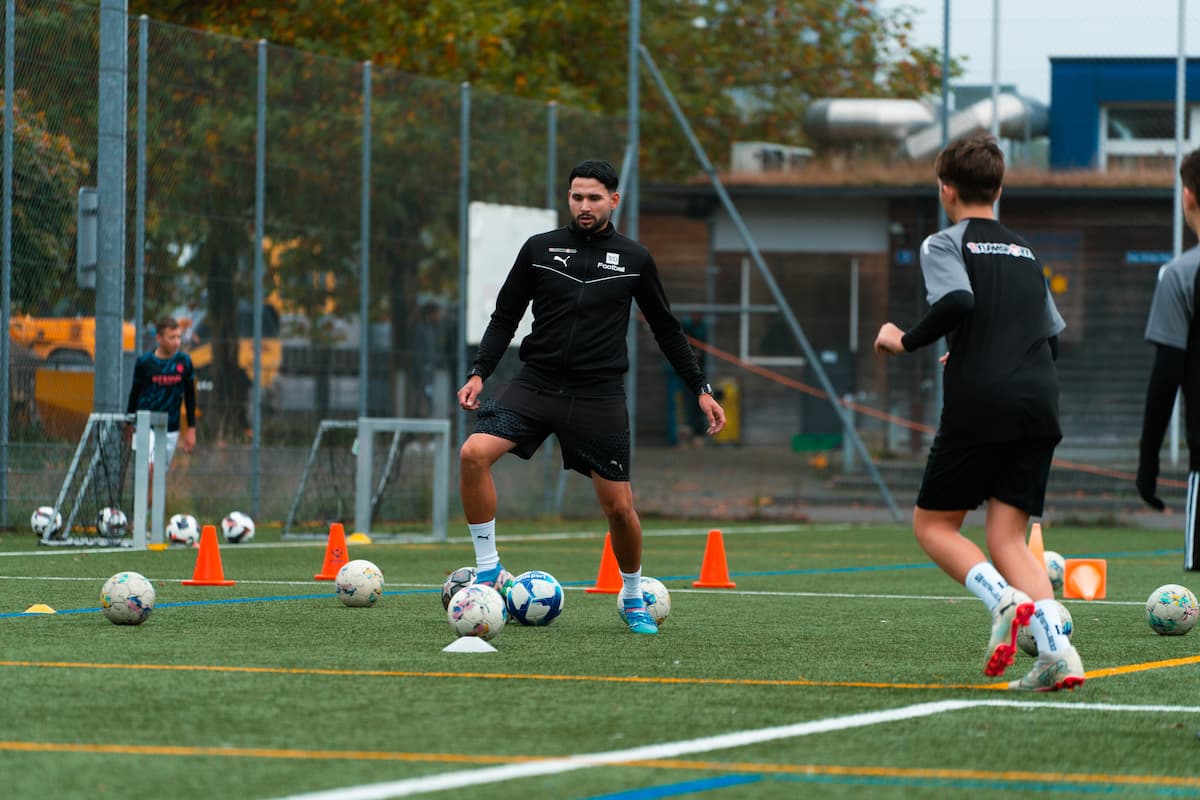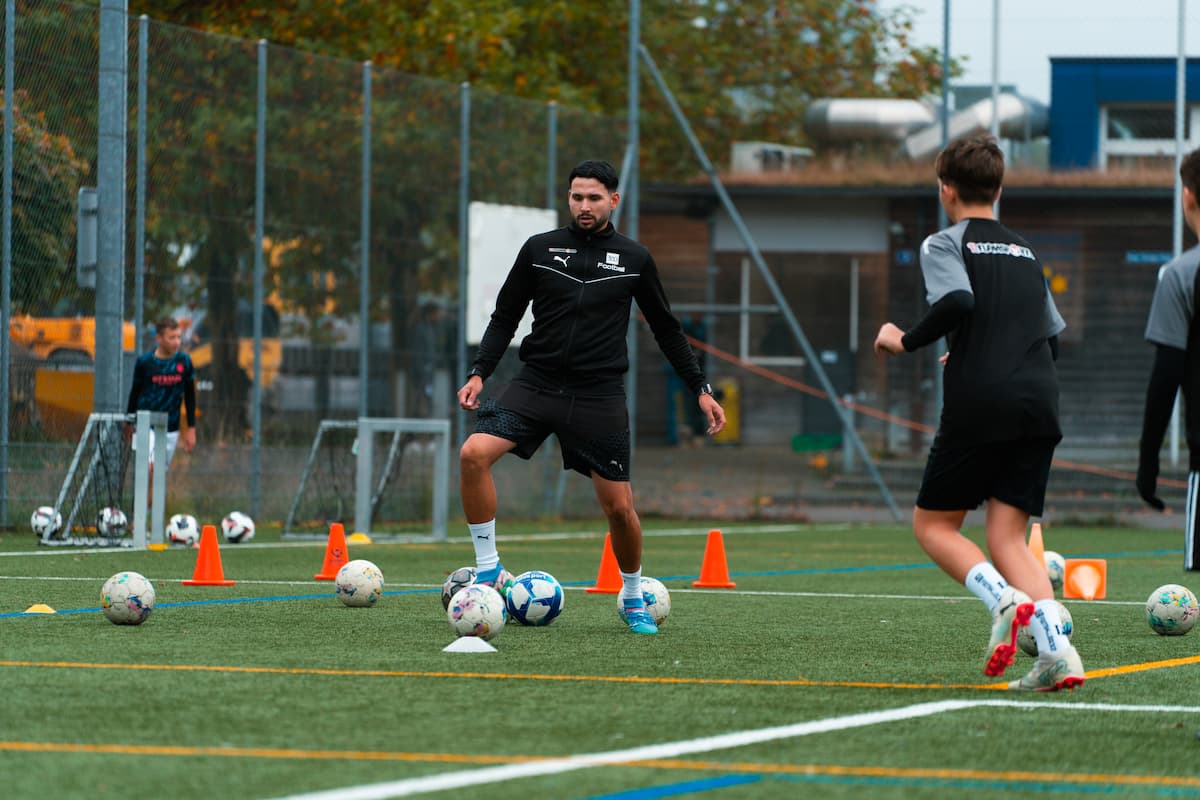The position of the full-back can be interpreted very differently. There are full-backs who focus almost exclusively on defensive work. At the same time, there are also defenders on the wings who are always on the way forward and sometimes neglect their tasks against the ball.
Ideally, as a full-back, you will fulfill both tasks - both the offensive and defensive responsibilities of your position. This can be very demanding under certain circumstances. Especially if your wing is only partially occupied.
If you play in a 4-4-2 or 4-1-4-1, your wings are doubled. In this case, you have a winger in front of you who supports you in both offensive and defensive tasks. However, if your coach prefers a formation with only one player on each wing, you are on your own on the wing.
In this case, as a full-back, you have to cover your entire side from your own baseline to the opponent's baseline. This means a lot of legwork for you. The many runs and sprints that you will complete during the game will pay off for your team. If you do your job both with and without the ball, your teammates can concentrate fully on the center and the half spaces.
In order for you to be able to master your side for over 90 minutes, you need good stamina. This video will help you build extremely good fitness:
The defensive 1 against 1 on the wing
If you have good stamina as a full-back, you will be able to get back behind the ball even after unsuccessful attacks. But then it's not necessarily a case of relaxation, but often a defensive 1-on-1.
Especially as a full-back, you will often find yourself in 1-on-1 situations because there is more space on the wings than in the center. This space makes it easier to outplay defenders. In addition, you often have to deal with opponents on the wings who have an explosive start and outstanding technique and who like to dribble - so 1 on 1 on the wing can be very demanding for you.
Positional play in front of a defensive 1 on 1 on the wing
Of course, you could stay close to this opponent for 90 minutes so as not to give them any space for a 1-on-1. However, this would create too big a gap between you and the next central defender - a passing window that the opponent could easily use. At the same time, you should of course also get to the opposing winger in time so that he cannot pick up the pace and thus gain an advantage for a 1 on 1.
As a full-back, it is important to find the right width and the best time to push out in order to have access to your opponent and at the same time be able to prevent an interface pass.
That's why you shouldn't be too close to your opponent immediately before a pass from the half-space...

moving in too far...

...but find the ideal distance. This will help you keep the passing window closed and not give the opposing wing play any time to gain momentum.

Win the defensive 1 on 1 on the wing
If you got out in time and weren't able to intercept the pass but were at least able to catch your opponent, you now have to win the 1 on 1 game.
When playing defensively 1 on 1 on the outside lane, it is important that you position yourself slightly inwards from your opponent. This also gives you access to the winger in possession of the ball when he tries to dribble into the middle of the field.
If the winger is moving particularly quickly, you should first retreat to the side to avoid being overrun. The backwards movement helps you slow down your opponent and thereby put you in a better position to win the ball.
If your opponent has come to a standstill or is no longer moving so quickly, you can confront him. If the opponent then tries to break through, nothing stands in the way of winning the ball if...
- ... in the sideways position you have lowered your body's center of gravity and are standing on your forefeet. This helps you pick up speed more quickly and get to the ball before your opponent
- ... you have an explosive start and can react quickly to your opponent's change of direction. This helps you to be able to react to sudden hacks, feints and attacks from your opponent
These two exercises will help you to be unbeatable in defensive 1v1 on the wing.
Explosiveness:
Quick changes of direction:
Offensive actions
As a full-back, your qualities are not only required in 1-on-1 situations against the ball, but also with the ball. Modern full-backs are characterized by the fact that they repeatedly get involved in their team's offensive game - not only through dribbling, but also through interaction with the attacking wingers.
The offensive calls of full-backs are often initiated by shifting play. For example, if there is no way through on your opposite side, the play equipment is quickly moved to your outer lane.
If you as a full-back receive the ball after the shift, you usually have a lot of space available on your side. In order to use this free space, you must not waste any unnecessary time processing the ball. Otherwise the opponent is shifted back to your side and the space is too narrow.
First contact
For this reason, as a full-back you need good first contact. You should be able to move a ball cleanly and without losing speed.
But you should be able to process not only flat balls but also high balls quickly, as many game shifts are carried out with the help of flying balls. To do this, you take the ball with your chest in the direction of play, for example. The second contact then occurs immediately after the ball comes into contact with the ground. You touch the ball with the outside or inside of your foot immediately after it touches the turf. You also hit the ball slightly above the middle. This way you flatten the ball quickly and therefore have better control over the ball.
With the help of this exercise you will be able to take the ball cleanly and with an explosive start:
So that you can process high balls at the highest speed, practice this exercise:
Combination play on the wing
If you have processed the ball cleanly and quickly, nothing stands in the way of a high-speed attack. If you still have support from a winger on the wing, you can leave your opponents behind you with an effective combination game. Running in front and behind is particularly suitable.
Running in front
When running forward, the winger dribbles at the opposing full-back in front of him. At the same time, you start going deep behind the opposing full-back at top speed. As soon as you are level with the opponent, the winger passes you in depth.

Running behind
Running behind works in the same way as running in front. There is only the small difference that you don't start behind the opposing full-back, but behind the winger with the ball. You run closely past your teammate. He then plays the ball into your path or dribbles himself towards the middle of the field.
If the winger decides to dribble into the middle of the field, running behind was still not in vain. Your running path forces the opposing defender to briefly move backwards and outwards in order to possibly still have access to you when you are deployed. This opens the way for your teammate to the center.

Regardless of whether you decide to run in front and behind, the combination only becomes truly effective when you start into the depths at the highest speed. For this reason, you should work on your speed regularly. This video will help measure your sprint training progress:
Be sure to check out our other blog posts for position-specific tips and general exercises and help for your training.
About the author:
Luis Österlein (Twitter: LOsterlein ) is a game analyst for the U23 team at FC Bayern Munich and a freelance author. In close collaboration with 360Football, he writes specific blog posts that support players in their football development support.


